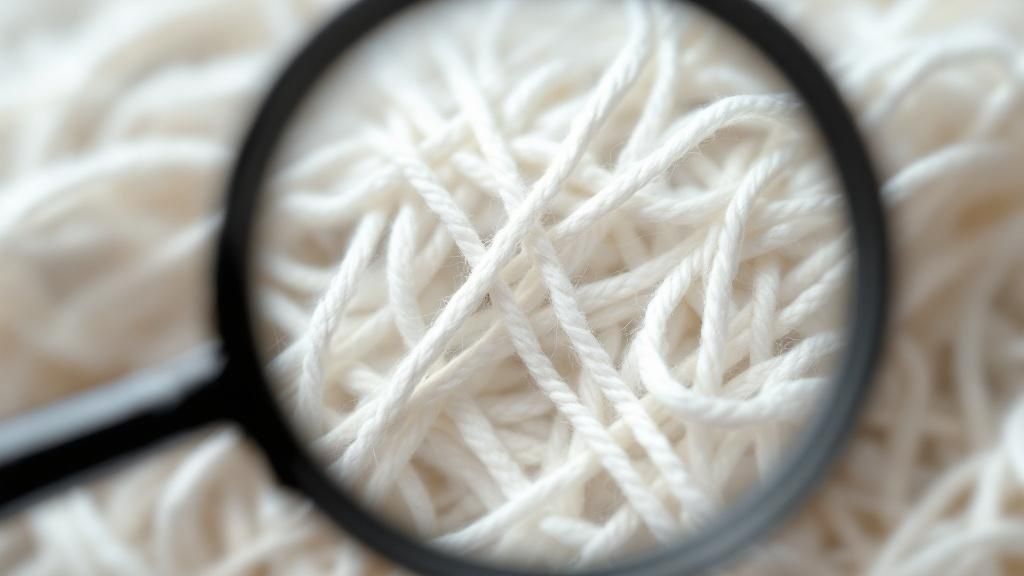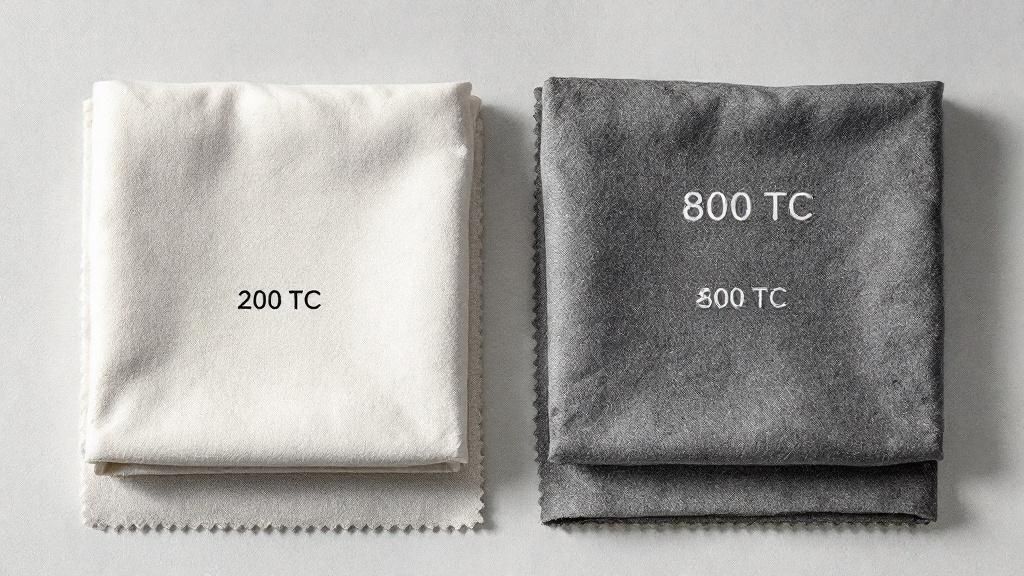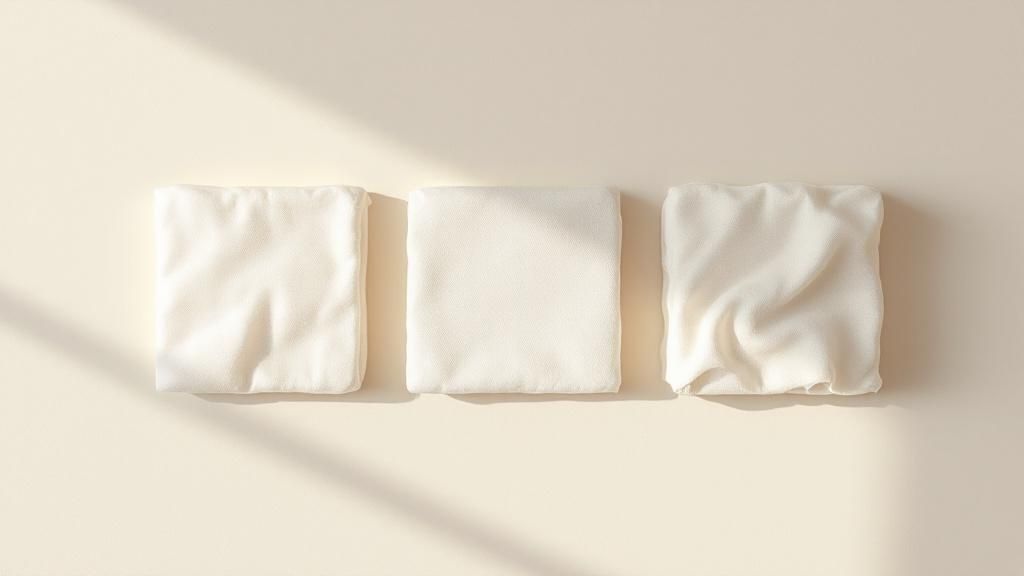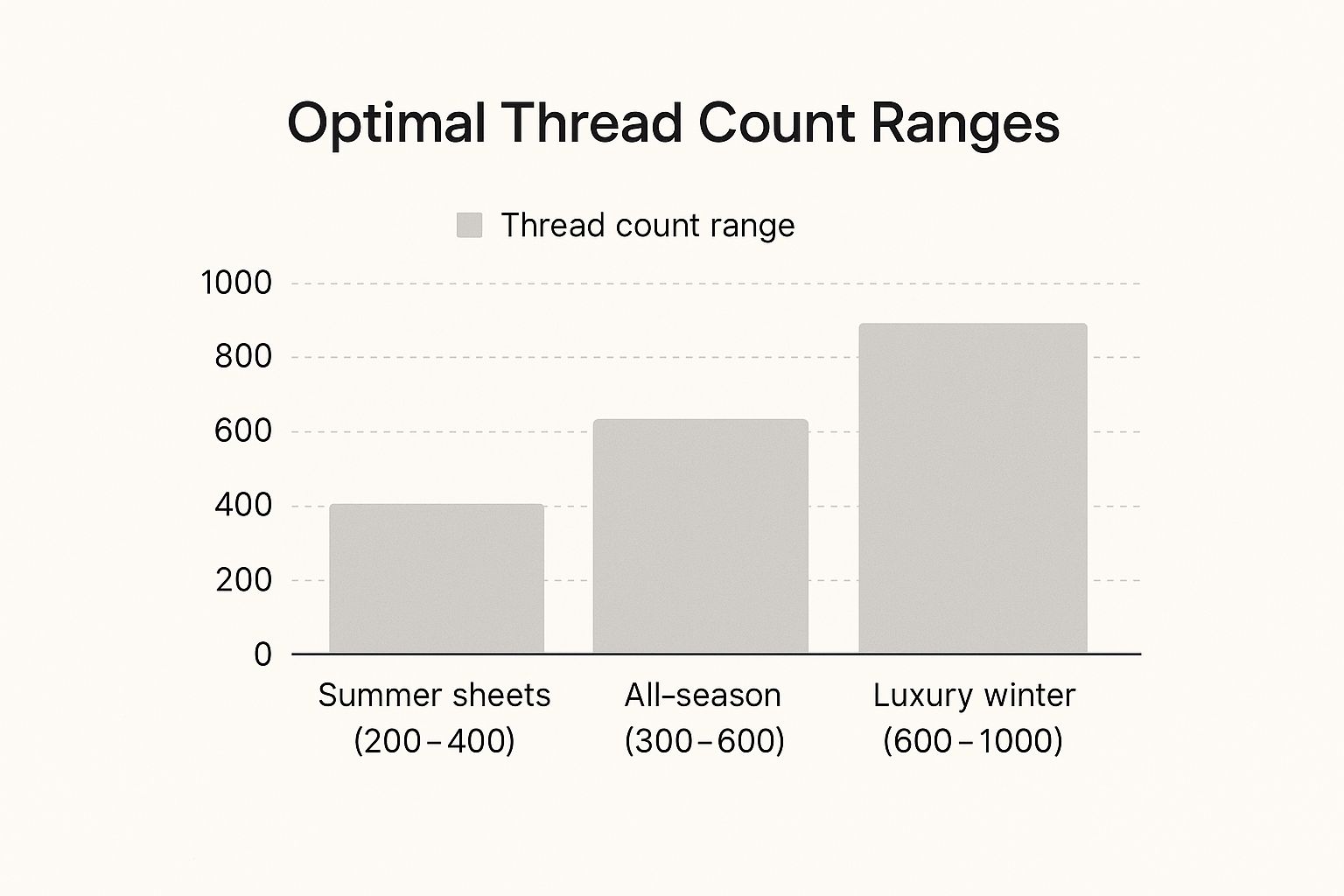If you're looking for the best thread count for sheets, let's cut through the marketing noise. For high-quality cotton, the real sweet spot is between 300 and 500. This range gives you that perfect blend of softness, lasting durability, and breathability—the kind you’d find in a luxury hotel—without feeling stuffy or overly heavy.
The Real Sweet Spot for Sheet Thread Count

So, what is thread count anyway? It's simply the total number of threads—both vertical (warp) and horizontal (weft)—woven into one square inch of fabric. While it's a measure of density, it’s definitely not the only sign of quality. Many brands have gotten very good at inflating this number, tricking people into thinking a 1,000-thread-count sheet is the absolute best you can buy.
The truth is a bit more complicated. An extremely high thread count can actually work against you, resulting in sheets that feel stiff, trap body heat, and don't let your skin breathe. If you tend to sleep hot or live in a warmer climate, those super-dense sheets can quickly become your worst enemy.
Finding Your Ideal Number
The best thread count isn't a single magic number; it really comes down to the fabric's material and weave. As a general rule, you want to see a minimum of 200, since anything lower will likely feel rough and cheap.
Most sleep experts and textile pros agree that the sweet spot for comfort generally falls between 200 and 800. For example, both standard cotton and premium Egyptian cotton really shine in the 300 to 400 range. If you want to dive deeper, you can learn more about how material impacts ideal thread count on SleepFoundation.org.
Here's what you really need to remember: The quality of the fiber, the length of the staple (the individual cotton fibers), and the type of weave are far more important than just a high thread count number.
To help you navigate your options, here's a quick breakdown of what to look for with the most popular sheet materials.
Quick Guide to Ideal Thread Count by Fabric
This table is a handy reference guide, showing you the recommended thread count ranges for the most common sheet fabrics and weaves you'll encounter.
| Fabric/Weave Type | Recommended Thread Count Range | Feels Like |
|---|---|---|
| Percale Cotton | 200-400 | Crisp, cool, and lightweight |
| Sateen Cotton | 300-600 | Silky, smooth, and slightly heavier |
| Egyptian Cotton | 300-500 | Exceptionally soft, strong, and breathable |
| Bamboo Viscose | 250-400 | Buttery-soft, cooling, and moisture-wicking |
| Linen | 80-140 | Airy, textured, and incredibly breathable |
As you can see, a material like linen has a naturally low thread count but is prized for its breathability, while a sateen weave needs a higher count to achieve its signature silky feel. Use this as your starting point, but always prioritize the quality of the material itself.
Why Higher Thread Count Isn't Always Better

We've all been led to believe that a 1,000-thread-count sheet set is the absolute peak of luxury. It's one of the most persistent myths in the bedding world, and frankly, it’s often a marketing gimmick. Those sky-high numbers you see on the packaging are frequently the result of manufacturing shortcuts, not a sign of better quality.
So how do they do it? The most common trick is using multi-ply yarns. A manufacturer will twist several shorter, weaker threads together to create a single strand. Then, they count each of those tiny, individual threads. This inflates the final thread count on the package without actually making the sheets feel better or last longer.
You end up with bedding that's surprisingly heavy and dense, not soft and airy. This kind of fabric traps heat, feels stiff, and is far more likely to start pilling after just a few washes. This is a perfect example of why focusing on thread count alone is a recipe for disappointment.
Quality Over Quantity: What Really Matters
Let's imagine a real-world comparison. You have two options: a 400-thread-count set made from high-quality, single-ply, long-staple cotton, or an 800-thread-count set made from cheaper multi-ply cotton.
Which one do you think actually feels better? I can tell you from experience, the 400-count sheet will win every time. It’s going to feel softer, breathe better, and hold up for years, giving you a much more comfortable sleep. This simple scenario shows that the quality of the yarn is what you should be looking for, not just the count.
A bigger number on the package doesn't guarantee a better night's sleep. True luxury comes from superior materials and honest craftsmanship, not inflated stats.
Independent testing consistently finds that the sweet spot for cotton sheets, where you get the best balance of softness and durability, is between 300 and 500. Anything in this range feels fantastic. Once you go much higher than 500, you're often paying for clever marketing rather than any real improvement in comfort. You can discover more insights about these findings to see what the experts have to say.
The bottom line is simple: stop chasing the highest number. Instead, focus on the things that genuinely make a difference.
How Thread Count Impacts Your Sleep Temperature

When you're shopping for sheets, it's easy to get caught up in the idea that a higher thread count means better quality. But when it comes to staying cool at night, that’s a myth that can lead to some seriously sweaty nights. The truth is, thread count has a massive impact on your sleep temperature, and it all boils down to one simple factor: breathability.
Think of it this way: fabric with a lower thread count has a more open weave. Those tiny, invisible spaces between the threads are your best friend if you're a hot sleeper. They let air move freely, which is exactly what you need to wick away moisture and allow body heat to dissipate. Without that airflow, you're just trapping heat under the covers with you.
Finding Your Comfort Zone
So, what’s the magic number? From my experience, you don't need to chase those sky-high thread counts to get a great night's sleep. In fact, you're better off doing the opposite.
For the best temperature regulation, sheets with a thread count between 200 and 400 are typically the sweet spot. This range strikes the perfect balance between a soft, comfortable feel and excellent breathability.
- For Hot Sleepers: This is your ideal zone. Sheets in this range won't trap heat, helping you avoid waking up in a sweat.
- For Warm Climates: If you live somewhere with blistering summers, having breathable bedding isn't a luxury—it's a necessity for getting any real rest.
On the other hand, those sheets advertising an 800 thread count (or higher) are woven incredibly tightly. That dense fabric feels heavy and acts like a thermal barrier, locking in your body heat and making you feel stuffy. You can find more tips and sheet recommendations in our complete guide to cooling bed sheets.
The biggest takeaway here is that for a cooler sleep, breathability beats density every single time. A lower thread count isn't a sign of poor quality; it's a deliberate feature for better comfort.
This isn't just anecdotal, either. Textile experts have shown that sheets in that 200 to 400 range offer far superior airflow, which helps keep your skin temperature cooler all night long. Choosing sheets in this range means your bedding is actually working with you, not against you, in the fight for a comfortable sleep.
You’ve probably heard that a higher thread count means better sheets, but that’s one of the biggest myths in the bedding world. The truth is, a 400 thread count in one fabric feels completely different from a 400 thread count in another. The material and weave are what really matter.
The best thread count for sheets isn’t a single magic number; it’s a range that depends entirely on the fabric you're sleeping on.
Take linen, for example. A 120-thread-count linen sheet is the definition of breezy luxury, perfect for staying cool on a summer night. If you found a cotton sheet with that same thread count, it would likely feel coarse and flimsy. Why the difference? Linen fibers are naturally much thicker than cotton, so you need fewer of them to weave a strong, beautiful, and long-lasting fabric.
Cotton Weaves: Crisp Percale vs. Silky Sateen
Even within the same material, like cotton, the weaving style completely changes the game. The two most common weaves you'll encounter are percale and sateen, and they feel worlds apart.
-
Percale Weave: Think of a classic, high-end hotel sheet—that's percale. It has a simple, grid-like weave that makes it feel crisp, cool, and incredibly breathable. For percale, the sweet spot is a thread count between 200-400. Pushing it much higher than that can actually trap heat, defeating the purpose of its airy feel.
-
Sateen Weave: Sateen is all about silky softness. Its unique weave exposes more threads on the surface, giving it a subtle luster and a smooth, buttery feel. It's a bit heavier than percale and drapes beautifully. Here, a higher thread count of 300-600 is ideal to really bring out that signature luxuriousness.
This chart helps visualize how thread count aligns with different comfort preferences across the seasons.

As you can see, the cooler, more breathable options generally sit in the lower thread count ranges, while the cozier, warmer sheets are found at the higher end.
Thread Count and Feel Across Different Weaves
To make it even clearer, here’s a quick breakdown of how common weaves stack up when it comes to thread count and feel. This can help you pinpoint the exact texture you're looking for.
| Weave Type | Ideal Thread Count | Primary Characteristic | Best For |
|---|---|---|---|
| Percale | 200-400 | Crisp, matte, and cool | Hot sleepers; a classic "hotel bed" feel |
| Sateen | 300-600 | Silky, smooth, lustrous | Those who want a soft, luxurious drape |
| Linen | 80-150 | Airy, textured, durable | Warm climates; a relaxed, casual look |
| Bamboo | 250-400 | Buttery-soft, cooling | Sensitive skin; eco-conscious buyers |
This table really highlights how a "good" number for one weave might be completely wrong for another. It's all about matching the count to the fabric's natural properties.
What About Other Materials?
Once you step outside the world of cotton, the rules for thread count change yet again. For modern fabrics like bamboo or microfiber, the number on the package becomes far less of a deciding factor.
Materials like viscose from bamboo, for example, are made from naturally long, smooth fibers. This means they create an incredibly soft fabric without needing a sky-high thread count. A set of bamboo sheets in the 250-400 thread count range will deliver that cooling, buttery-soft feel the material is famous for. If you want to dive deeper, you can learn more about bamboo sheets and what makes them a fantastic option for anyone with sensitive skin.
When you're looking at alternative fabrics like bamboo, linen, or even microfiber, shift your focus from thread count to the quality of the raw material itself. A well-crafted, lower-count bamboo sheet will almost always feel more luxurious than a poorly made cotton sheet with an inflated thread count.
What Actually Matters More Than Thread Count
If you've ever bought sheets, you've probably been told to look for a high thread count. But honestly, focusing only on that number is like judging a book by its cover—it misses the whole story. What truly makes for incredible, long-lasting bedding comes down to a few key details that have nothing to do with hitting a specific number.
The real trifecta of sheet quality is fiber type, staple length, and weave. These three things are the engine, the transmission, and the suspension of your bedding. They dictate how a sheet feels against your skin, how well it breathes through the night, and how it holds up after countless trips through the laundry. Nail this combination, and you've found a set that will feel amazing for years, not just a few weeks.
The Foundation of Quality Fiber
Let's start with the most important element: the fiber itself. The raw material is everything. You can have a sky-high thread count, but if it's made from cheap, low-grade fibers, it’s just not going to feel good.
-
Fiber Type: This is the plant or material your sheets are made from. We all know about high-end options like Egyptian and Pima cotton, but other materials bring their own unique advantages to the table. For example, the antibacterial benefits of bamboo sheets are a game-changer for anyone with sensitive skin.
-
Staple Length: Think of this as the length of the individual cotton (or other) fibers. When you have long-staple fibers, they can be spun into yarn that’s incredibly fine, strong, and smooth. The result? Sheets that resist pilling and feel exceptionally soft.
Here's the bottom line: A 400-thread-count sheet made from premium, long-staple Egyptian cotton will feel far more luxurious and outlast an 800-thread-count sheet woven from cheap, short-staple cotton. Every single time.
How Weave Shapes the Feel
Finally, the way those fibers are woven together makes a huge difference in the final feel and performance. For cotton sheets, the two most common weaves you'll encounter are percale and sateen, and they create two totally different experiences.
A percale weave is built on a simple one-thread-over, one-thread-under grid pattern. This creates a fabric that's light, crisp, and has a classic matte finish. If you love that cool-to-the-touch feeling when you slip into bed, especially if you're a hot sleeper, percale is for you.
On the other hand, a sateen weave follows a one-under, three-or-four-over pattern. This exposes more of the thread's surface, giving the fabric a silky, buttery-smooth feel and a beautiful, subtle sheen. Sateen sheets are a bit weightier and cozier, making them perfect if you want to wrap yourself in pure softness.
So, instead of just chasing a number, think about what you actually want from your sheets. Do you want crisp and cool, or soft and silky? The answer lies in the weave, not just the thread count.
Even after you've done your research, a few nagging questions can pop up right before you're ready to buy new sheets. Let's tackle some of the most common ones I hear so you can feel totally confident in your choice.
Does a Higher Thread Count Mean the Sheets Will Last Longer?
Not necessarily. The real secret to durability isn't the thread count, but the quality of the fiber itself—specifically, the staple length.
Think of it this way: a set of 400-thread-count sheets made from long-staple Egyptian cotton will almost always outlast a 1000-thread-count set woven from weaker, short-staple fibers. In fact, cramming too many threads into a small space can sometimes lead to more pilling over time, not less.
What Is the Best Thread Count for Hot Sleepers?
If you tend to overheat at night, your main goal is breathability. For sheets that keep you cool, stick to a thread count between 200 and 400. This sweet spot provides enough softness without being so dense that it traps body heat.
Pro-tip for an even cooler sleep: Look for a percale weave within that thread count range. Its crisp, grid-like structure is specifically designed to let air circulate, making it a game-changer for anyone who runs hot.
Is There a Minimum Thread Count I Should Look For?
Yes, there is. For 100% cotton sheets, I'd recommend using 200 as your absolute minimum. Anything below that benchmark often feels rough against the skin and tends to wear out quickly after just a few washes.
Sticking to this minimum ensures the weave is tight enough to feel soft and durable, giving you a reliable baseline for both quality and comfort.
Ready for a truly restorative sleep? Bamtek crafts premium, 100% organic bamboo bedding designed to keep you comfortable all night long. Explore our collection of cooling, hypoallergenic sheets at https://bamtekhome.com.










